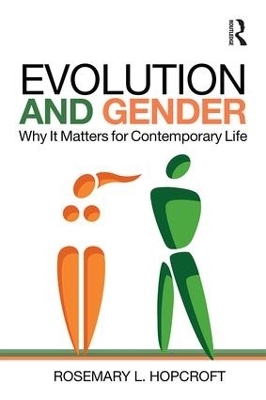
Evolution and Gender
Routledge (Verlag)
978-1-138-95616-2 (ISBN)
Hopcroft shows that gender differences in physiology, psychology, and behavior can be traced to slight differences in evolved traits between men and women. These differences exist because of sex differences in investment in offspring, which meant that, in the environment of evolution, some adaptive problems were more important for men to solve than for women, and vice versa. For men, the most important adaptive problem to solve was that of finding a mate. Men who did not solve this problem are not our ancestors. For women, the most important adaptive problem to solve was that of successfully bearing and raising children. Women who did not solve this problem are not our ancestors. These small differences underlie all the differences described in the book, including sex differences in mate preferences, physiology, cognition, aggression, status striving, and emotional experience. It can also help explain the differential treatment of children by parents, the differential success of boys and girls in modern schools, and sex differences in style of communication.
Rosemary L. Hopcroft is Professor of Sociology at the University of North Carolina at Charlotte. She has published widely in the areas of comparative and historical sociology and evolution, biology, and society in journals that include the American Sociological Review, American Journal of Sociology, and Social Forces. She is the author of Sociology: A Bio-Social Introduction (Paradigm 2010).
Part I: Introduction
Chapter 1: Evolutionary theory and the Sociology of Gender- A bad beginning
Part II: Sex Differences in Evolved Mating Strategies
Chapter 2: Gender and evolution
Chapter 3: Women's evolved long term mating strategies
Chapter 4: Men's evolved long term mating strategies
Chapter 5: What is beauty? Why do we want it?
Chapter 6: Sex differences in short term sexual strategies
Part III. Women and Men
Chapter 7: Evolutionary origins of patriarchy: Societal control of women through the ages
Chapter 8: Physiological differences between the sexes
Chapter 9: Cognitive differences between the sexes
Chapter 10: An evolutionary view of the reproductive lifecourse of women
Chapter 11: Sex differences in aggression and criminality
Chapter 12: Sex differences in status striving
Chapter 13: Gender and emotion
Part IV. Implications of Sex Differences
Chapter 14: Parental strategies: Differences by child's gender
Chapter 15: Boys and girls in school
Chapter 16: Conflict between the sexes
Chapter 17: But can they talk it out? Problems of communication
Chapter 18: Conclusion
| Zusatzinfo | 4 Tables, black and white; 22 Line drawings, black and white; 5 Halftones, black and white; 27 Illustrations, black and white |
|---|---|
| Verlagsort | London |
| Sprache | englisch |
| Maße | 152 x 229 mm |
| Gewicht | 362 g |
| Themenwelt | Studium ► 1. Studienabschnitt (Vorklinik) ► Med. Psychologie / Soziologie |
| Naturwissenschaften ► Biologie ► Evolution | |
| Sozialwissenschaften ► Ethnologie | |
| Sozialwissenschaften ► Soziologie ► Gender Studies | |
| ISBN-10 | 1-138-95616-3 / 1138956163 |
| ISBN-13 | 978-1-138-95616-2 / 9781138956162 |
| Zustand | Neuware |
| Haben Sie eine Frage zum Produkt? |
aus dem Bereich


